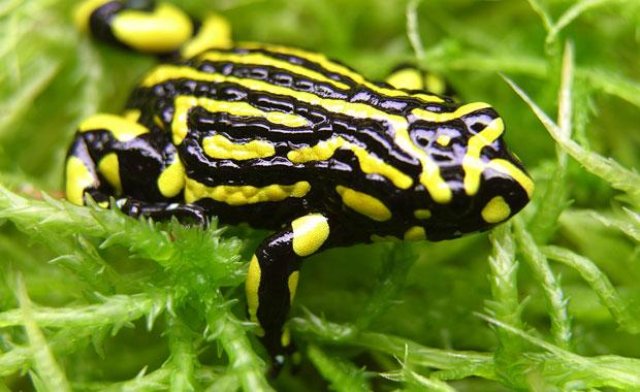
Biologists consider the health of frogs to be indicative of the health of the biosphere as a whole.
Frogs have permeable skin that easily absorbs toxins. They require specific aquatic and terrestrial environments to survive and breed, making them highly susceptible to environmental disturbances. Because of this they are considered accurate indicators of environmental stress.
Frogs have lived on the Earth for 250 million years, surviving ice ages and other climate changes. Yet around the world, populations of amphibians, particularly frogs, are now in drastic decline.
In Australia, nine frog species have become extinct in the past 25 years. Several more are likely to disappear in the near future. A further 27 species of frog are under threat.
Unlike the slow decline of many other Australian animals, frogs thrived along the east coast and inland areas until the 1970s. Then, within five years, their numbers went into catastrophic decline, reducing them to just one-tenth of their former numbers.
Scientists estimate that some frogs, such as the Southern Corroboree frog — which once numbered in the hundreds of thousands — now have fewer than 100 individuals, representing about 0.001% of their population three decades ago.
Scientists say the usual suspects may explain the extinctions — habitat loss and “human activities”. Australian frogs are also susceptible to the chytrid fungus, which is decimating frog populations around the world.
It is thought that this often-fatal disease was accidentally introduced to Australia in the late 1970s. The fungus eats keratin, the main protein in frog skin, which frogs need for protection, and to breathe and drink through. Infected frogs simply suffocate. There is no effective infection control for the fungus.
However, the main threat to Australian frogs comes from human impacts, such as climate change, habitat disturbance and feral animals.
Frogs, more than any other terrestrial animal, need water to survive. In inland wetlands along the east coast of Australia, frogs depend on the flooding of wetlands to successfully breed. But as droughts become more common — and more floodwaters are diverted to agriculture — the wetlands dry out and the frogs are unable to breed.
Humans have many other impacts on frog survival, such as clearing native vegetation for urban growth or agriculture; removing fallen timber, leaf litter and other ground cover; draining wetlands or allowing sheep and cattle to graze on them; collecting bush rock that frogs use for shelter; burning the bush, which reduces the quality of wildlife corridors and makes it difficult for frogs to move from one area to another; polluting waterways with chemicals and runoff; and introducing exotic predator fish such as the plague minnow, trout, carp and goldfish, which eat frogs’ eggs and tadpoles.
Biologists warn that Victoria’s frogs, in particular, face a conservation crisis and fear that some of the state’s amphibians have “passed a tipping point”.
The prospects for the Baw Baw frog, Victoria’s only endemic frog species, are now considered “immediately bleak”.
This tiny frog can only be found in Victoria’s eastern Alpine region of Mount Baw Baw and a shipping container in inner Melbourne, in which Melbourne Zoo established a small “insurance” population of 57 frogs. Once thought to number between 20,000 and 30,000 frogs, fewer than 600 remain.
The Spotted Tree frog, found in rocky mountain streams in north-eastern Victoria, has lost more than half the known populations. The Growling Grass frog, which needs habitat corridors along creeks and waterways, has declined by 29% since 2001.
The Southern Corroboree frog is arguably Australia’s most endangered species. Only three centimetres long with black and yellow stripes, it is found only in small pockets of the sub-alpine area of Kosciuszko National Park.
Unlike most frogs, which lay eggs in water, the Southern Corroboree frog lays its eggs in a moss-lined nest on the bank of a bog. Autumn rains flood the nest and allow the tadpoles to hatch and swim into the bog.
Scientists believe that this breeding method is threatened by the increasingly dry weather and prevalence of drought in southern Australia since the mid-1980s. The frogs rely on the autumn rains to come at the right time.
The tadpole eggs cannot survive unpredictable shifts in rainfall. ABC Science explains: “If the rains arrive late, it delays the hatching of the tadpole. This means that come spring, the tadpole must wait longer until it metamorphoses into a frog, because it must remain a tadpole for a certain amount of time. But as the summer approaches, the bogs begin to dry out. If the water level drops too low before the tadpoles have changed into frogs, they will dry out and die.”
Frogs play an important role in the food web of wetlands and rivers — as predators and prey. Tadpoles are herbivores and help clean waterways by feeding on algae as well as being prey.
Adult frogs also have an important role in the food web, feeding on insects, such as mosquitoes, and providing food for predators such as birds and reptiles.
As bioindicators of aquatic and wider environmental health, we should be concerned that frogs are disappearing. It should serve as our wake-up call that something is very wrong in the environment.
Like the article? Subscribe to Green Left now! You can also like us on Facebook and follow us on Twitter.